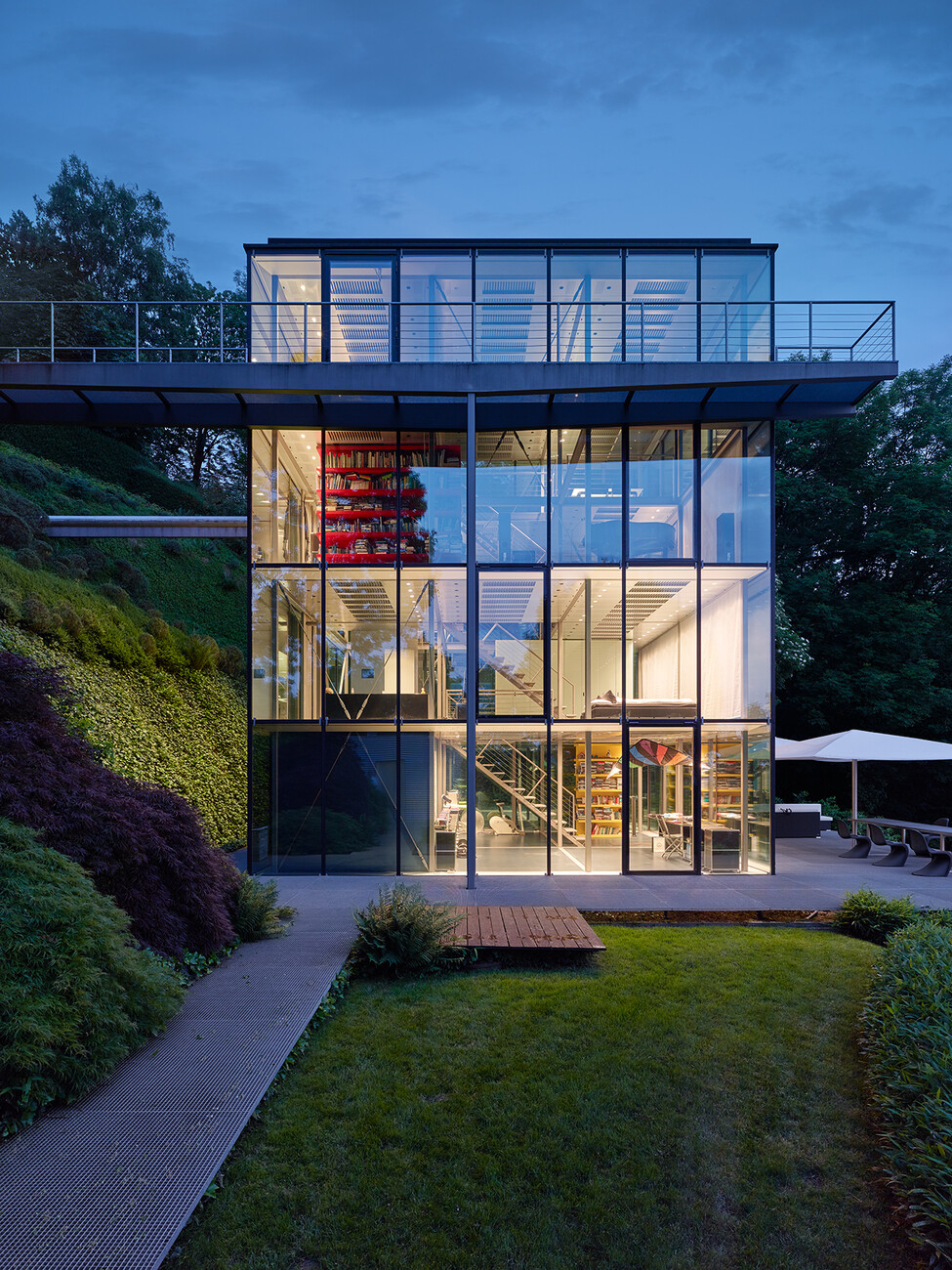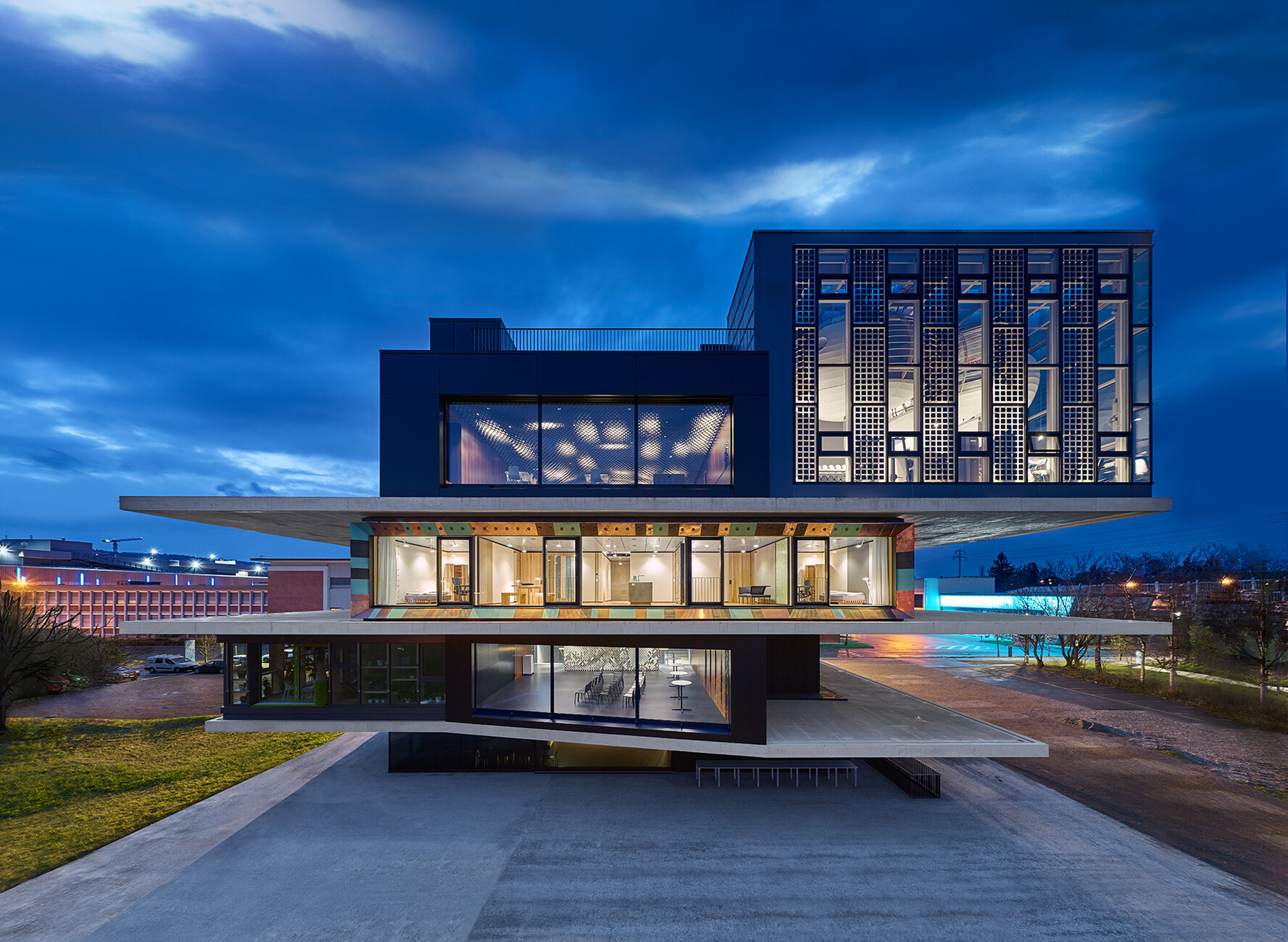SUSTAINABILITY
“Heading full-speed straight for disaster, whistling happily all the way”
Werner Sobek is one of the world’s most sought-after architects and engineers. He has designed everything that is large and difficult, from World Cup stadiums to skyscrapers, bridges and energy-plus houses. However, work on innovative supporting structures or research into new building materials and smart construction methods, the areas for which he is famous and renowned, are things that he now leaves largely to his successors as professors at Stuttgart University and in his offices. Because he has more important things to do. What he is concerned about is the well-being of future generations, starting with the upcoming one.
What Sobek has to say in his quiet, insistent voice leaves little scope for optimism. There is no hope for our global climate. Not really. Although Sobek certainly isn’t one of those itinerant preachers who herald the apocalypse. However, while coming up with energy-saving construction methods and zero energy homes he has learned to focus on the big picture. And, over the course of his painstaking research work he has gone into great detail to prove that a large quantity of the environment-related data with which the politicians and experts work and which they use for their arguments are not correct and in fact sometimes are downright wrong. Moreover, what is often missing are the requisite links and evaluations, not to mention the consequences plus information on what the politicians and society should be doing about the situation.
One example of how to correct the values we take for granted?
For two decades now one figure has been repeated so often that it has practically become general knowledge, i.e., the statement that the building industry is responsible for 40 percent of those emissions that harm our climate. However, the situation sounds far more dramatic when Sobek points out: “Wherein this figure are the emissions that are caused by manufacturing and transporting the building materials, where are those that are caused by demolishing a building? And where are the emissions caused by taking down the infrastructure works? They have not been factored into the equation. Indeed, if we add everything up, we come to an order of magnitude that is over 50 percent. This means that as a whole, the construction business accounts for the majority of emissions that are destroying the climate.”
Sobek identifies a large number of environmental disasters and crimes against the environment, both large and small. However, he focuses on the most important of them, global warming, and on the largest culprit, the emission of greenhouse gases. He leaves no doubt as to what this means: “It’s clearly impossible for us to achieve that 1.5 °C goal, even though a large number of people are still talking as if we could somehow keep to it. I just can’t imagine that anymore. However: If the annual average temperature worldwide rises by two degrees or more this means not only that many coastal regions will be flooded. Above all, it means that many regions will be gripped by periods of great drought and excessive temperatures, something which will lead to crop failures, dramatic famines, and a widespread scarcity of drinking water. And to the resultant migration of many millions of people which will be very difficult to control.” Even if the increase in global population and the worldwide standards of living were to stagnate, this would not put a brake on the emission of greenhouse gases. Seven more years like this and that would be it – then the rise in temperature will be irreversible.”
How does this relate to carbon?
“If we want to meet the 1.5 °C degree target, we must immediately start releasing at most only around 290 billion tons of carbon dioxide equivalent, i.e., carbon dioxide plus other climate-damaging gases such as methane, converted into their equivalent impact if measured in carbon dioxide. This sounds like a very large amount. However, we need to know that humankind releases around 1,300 tons of carbon dioxide into the atmosphere per second. This means that we will have used up our presently remaining quota of carbon dioxide in seven years’ time. That’s it. Then our target will have gone out of the window.” The government’s “climate targets” are a desperate attempt to stick to our quota for the time being. They are aimed at maintaining the status quo. But what comes next? Most calculations are based on today’s global standards of living and do not take the trends in the emerging markets and the developing nations into account. After all, who wants to deny the people in emerging nations access to progress and quality of life?
What does this mean, for example, in the construction industry?
“When we ask what volume of many building materials a person owns the answer is, on a global average, approx. 148 tons. However, in the Global South the figure is only around 76 tons. In the industrialized countries the figure is in fact over 400 tons per capita. We can say that the bottommost edge of the standard in the industrialized countries, the point, so to speak, of reaching the construction standards in the industrialized countries, stands at around 335 tons per capita. The industrial countries have extensive access to education, to healthcare, to infrastructure, things that are often lacking in the so-called Third World. If we want to make the standard available to the 6.6 billion people in the so-called Third World, we would need to provide around 1,800 billion tons of building materials. This translates into a 30-centimeter-thick concrete wall stretching right round the Equator and just short of 60 km high.”
Sobek’s conclusion: Humankind is not faced with an energy problem, we are faced with a problem of climate-killing emissions. In terms of the construction industry, we could replace the entire catalogue of measures to save energy with two sentences: “The emission of greenhouse gases is prohibited for the manufacture, operation and demolition of our built environment as of a point in time that has yet to be agreed. Unavoidable process-related emissions should be offset by compensatory measures.” There is nothing more to add to this. “Only” the date.
All this sounds pretty pessimistic. Even when Sobek goes on to mention specific measures: “If we are prepared to meet the statutory savings targets of 65 percent of carbon emissions compared with 1990, we need, over the coming eight years, to remove around 644,000 heating systems from our buildings every year and replace them with zero-emission systems. If in future all Germany’s electricians restricted themselves to replacing conventional heating systems with heat pumps or other systems, they would still only achieve a fraction of this figure. Moreover, another question needs answering, i.e., whether we are in the first place in a position to make these 644,000 systems available ready for installation and this includes all the other times that this involves. And who is going to manufacture all these products?”
Werner Sobek maintains the detached view of a scientist here. Anybody, for example, who declares that timber-frame buildings can play an important part in preventing greenhouse gas emissions in the construction sector needs to start thinking again, because wood is eminently unsuitable for building foundations of any kind, or for the construction of bridge piers, interstate flyovers, floodgates, high-speed train tunnels or subways. And according to Sobek’s calculations, buildings that use timber are by no means unproblematic or an ideal solution. To his mind, the amount of carbon such buildings actually save is considerably less than many people claim. He adds that trees need 10-15 years until they reach their maximum annual ability to absorb carbon. After this they should be left alone for at least another two to three decades. However, they are usually felled before this amount of time elapses. And then the saplings start again from scratch. A large part of the mass of a felled tree is accounted for its thermal use, in other words, the carbon stored by the tree is released back into the atmosphere in the form of carbon dioxide. Accordingly, whichever way we look at it, something that should be right at the top of our to-do lists is: “We must start planting trees like mad!”
Should we be building more with clay or bricks?
“Yes. However, we generally need to make sure that in future we work more with regional building materials so as to cut down on those emissions caused by transport. In other words, the necessary clay should not be trucked over a considerable distance. It needs to be available locally. And for high load-bearing structures it needs to be fired into bricks at approx. 900° C. Weatherproof clinker brick is fired in kilns at around 1,400°. None of this is a problem in technical terms. However, in future, we are going to have to stop using fossil fuels to produce energy. I can also imagine that using the natural stone available in a region might give the construction industry the shot in the arm it requires. Nevertheless, when all is said and done, what we need to do is save materials and transport less volumes – after all, the main problem is the emissions.”
Is there an optimum shape in terms of energy performance?
“That is difficult to say, particularly since the subject has not been sufficiently researched. However, we can say what isn’t an optimum shape in building. Freestanding detached and semi-detached houses. Compared with other, more compact building methods, these take up more space on our streets and longer paving as well as requiring particularly long supply and waste disposal pipelines.”
It certainly is the case that Sobek conducts datamining, that he amasses all the data and facts that are available to him. Then he makes that data manageable, comparable, if, for example, different protagonists have been working with various different units of measurement, with coal equivalents, exajoules or kWh, for instance. Then he explains, illustrates, assesses global and regional issues, traffic systems, materials, construction methods etc., everything with the intention of demonstrating the state of the world, irrefutably and in a brutally honest way, of revealing and exposing any attempts to gloss over this, to make excuses or to relativize. So as finally, as a last step, to arrive at his social and political conclusions and demands. These turn out to be extremely radical, since there are, as he points out, numerous initiatives, programs and political agendas. However, he adds, time is running out, everything is taking too much time, we need to act more quickly, more effectively and more radically.
We get the impression that Sobek is not particularly confident about the future: “We are heading full-speed straight for a disaster, whistling happily all the way,” is what he believes. “Humankind’s greatest tragedy is that none of us can either see or smell carbon dioxide.” Meaning the dramatic urgency of our climate catastrophe is simply impossible to convey.
A book has now been published about Sobek’s work. The first volume, initially an inventory, is the first in a trilogy. Its title: “non nobis – über das Bauen in der Zukunft. Band ein: Ausgehen muss man von dem, was ist” (non nobis – about the future of building. Volume one: We need to start with the status quo)”. It is disturbing. Volumes two and three will be published in the near future. In them, Sobek will be presenting the consequences and some possible courses of action.










